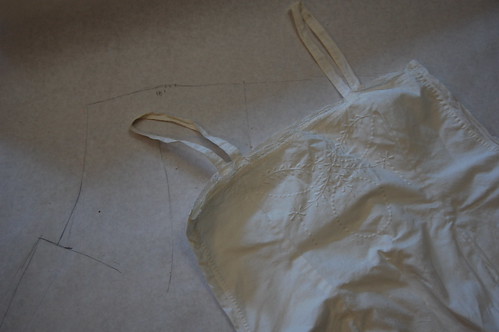
Yes, I have three names for one thing in the post title. You can't step in to them, so step-ins isn't quite right, but I wanted to include it because it's so similar. Combinations was a word that had been in use for some time, and teddy was a new word. I'm just covering different options!
I received an adorable 1920s teddy as a gift. It's absolutely perfect to wear under my upcoming tennis dress, so I thought now would be the perfect time to pattern it. It's quite simple, made of a front, back, straps, and crotch piece. There's extra fullness at the hips from a slashed and gathered dart. It's made of a heavy, crisp cotton. I'm making my reproduction in Southern Belle cotton that I bought at Nancy's Notions. It's not the same weight, but it has a nice crispness and weight to it.
The teddy is mostly machine sewn, with hand sewn buttonholes, lace hand sewn on, hand embroidery, and an alteration done by hand.
I'm reproducing this fairly closely. I'm not doing the alterations, where the sides were split and lightweight fabric was added, and I'm not doing the embroidery (at least for now!). I'm doing my best to follow the techniques of the original. I'm including a pattern from the original as well. I did realize after making it that I switched the order of sewing the dart and side seam. On the original, the side seam was sewn, then the dart. I sewed the dart, then the side seam. Eventually I'm going to do a detailed write up of the original on my other blog.
On to construction!
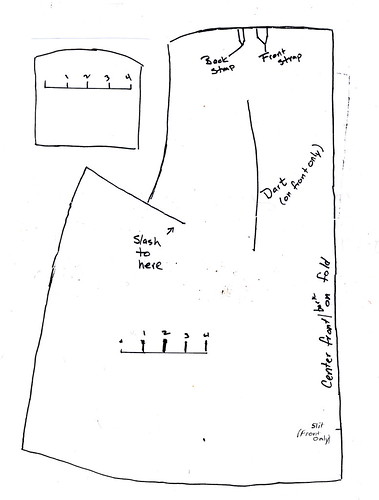
The pattern! The front and back are identical. The piece shaped vaguely like a piece of bread is the crotch piece. I left of the markings for where this is placed in back. It's sewn to the center back, and a small crescent shaped piece is cut away. This is described below. The pattern doesn't include seam allowances.
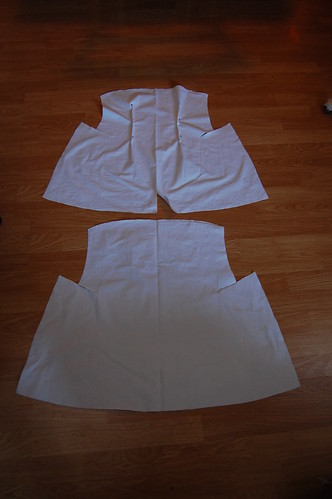
Here are the body pieces laid out. The darts are pinned into the front, and there's a small slit at center front. The crotch piece is sewn to the back and will button here. This slit will eventually be faced.
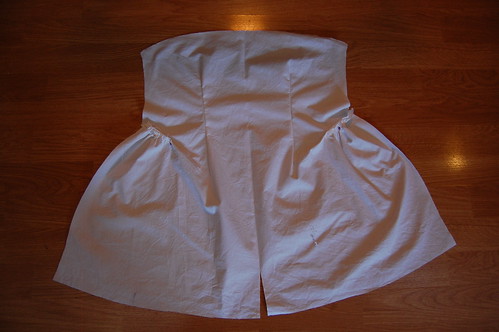
Run gathering threads on the bottom of the slit at the waist. Pull them to match the top of the slit. Pin the sides together so the seam allowance will be on the right side. You'll be making a French seam to cover this. This is the part that I did out of order--the original sewed the side seams, then this dart.
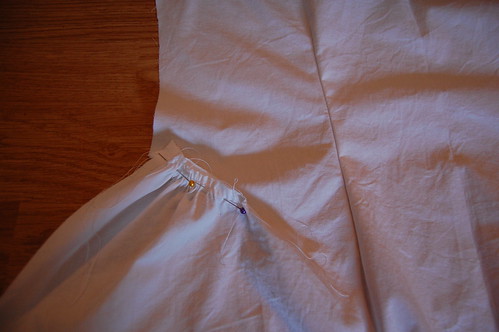
Here's a close up of the above.
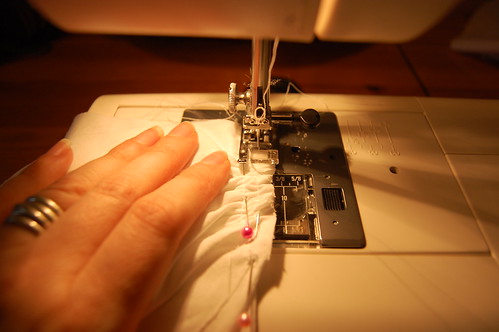
Sew this using a very small seam allowance. This is where using a firmly woven cotton comes in handy!
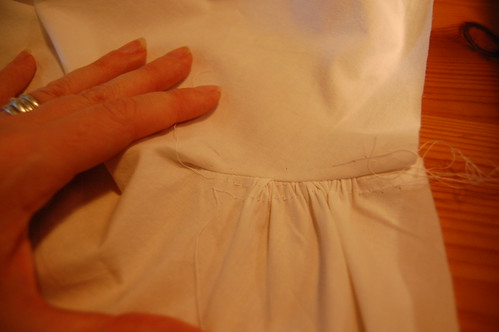
Here it is after it's sewn. I left the gathering threads in at this point to make the next step easier, but I did trim all the ends so it would get less tangled!
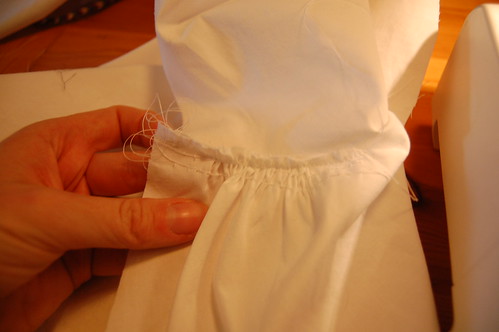
Here it is on the right side. This is what's going to be covered up in the next step.

Press the seam, and then fold over with the seam in the center to make a French seam. Pin a little past the gathers so you can make a dart that fades into the fabric.

Sew this with a narrow seam allowance, just enough to cover the previous seam. Press the seam up and remove the gathering threads.
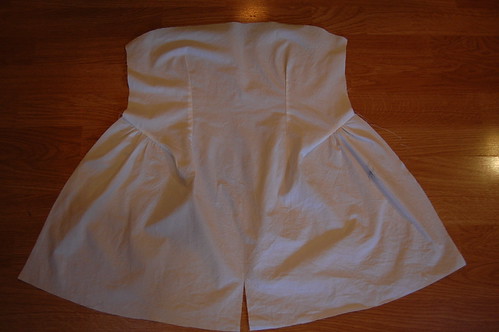
Here's the finished front piece!

And the same view from the back. The gathered slits just look like darts.
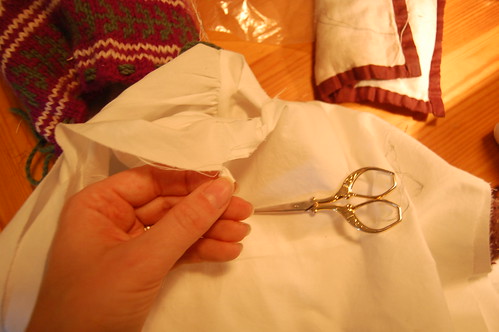
Trim any excess fabric from the edge of the darts.
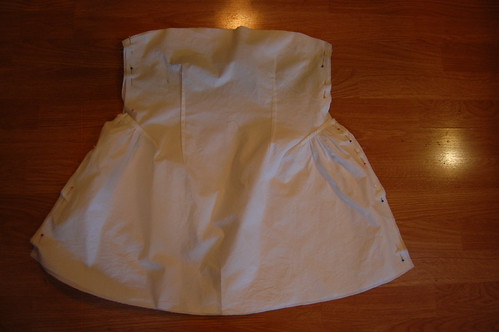
Pin the back to the front, offsetting the back edge out about 1/4 inch. This seam will be flat felled.
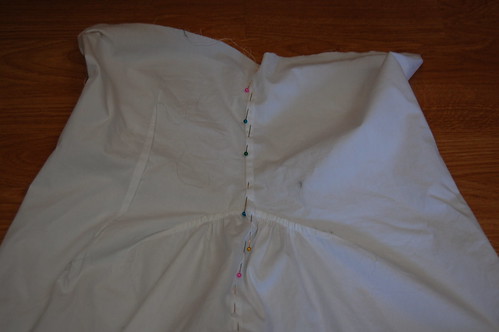
The seam ready to be flat felled.
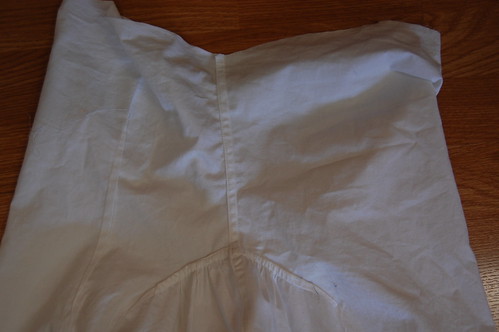
The felled seam!
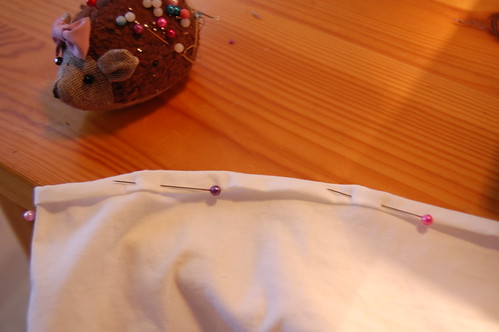
Fold the top down to hem, and hem by machine.
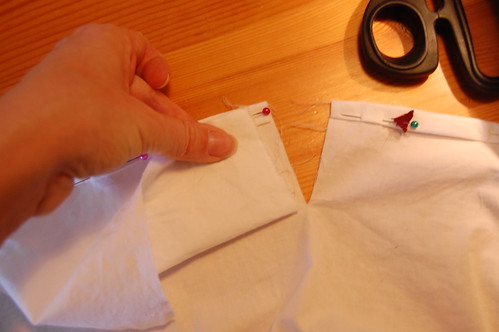
Now, start pinning the bottom edge hem. Make sure the size of the slit is the same as the size of the crotch piece. The crotch piece will be sewn to the back and button to the front.
Only one side of the crotch piece is hemmed in the original--the other is selvedge. My fabric had a nice selvedge, so I did it this way as well. You also need to hem the top edge where the buttonholes go, but I saved this until after I had a chance to try it on to make sure the length was ok.
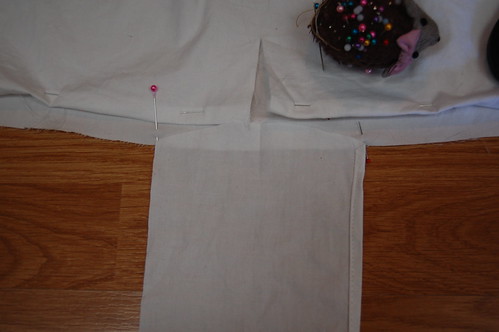
Now, mark where the crotch piece will go on the center back. You're not going to hem this section--it would be too thick with the flat felled seam.
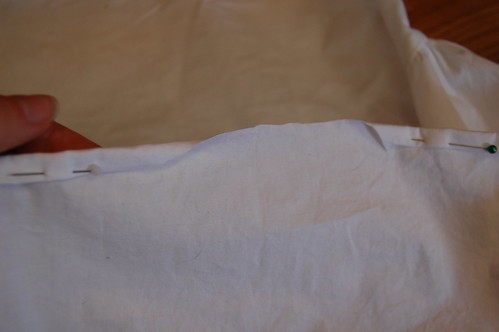
Finish pinning the bottom hem, going up to the marks. Cut a small crescent shape starting at the marks.

Hem the bottom edge by machine. You can see the crescent shape you cut earlier is even with the bottom hemmed edge. Pin the crotch piece to the unhemmed edge, offsetting it a bit for flat felling.

Sew the crotch piece in, matching the seamline to the hem.
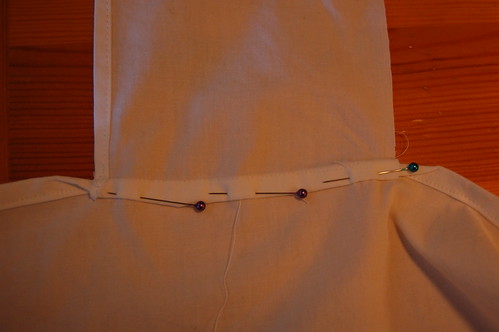
Fell the seam. You'll notice the hem turns up a bit. This is visible on the original as well.
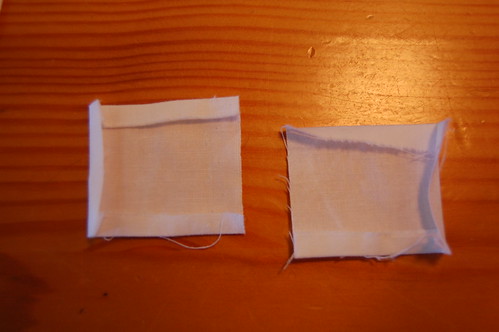
Now it's time for the front facing. I think the original facing may have been done before the slit was made, as I have instructions in a 1920s sewing book that say sew first, cut last. However, I decided to cut my slit first for measurement reasons. It's also possible that these two little facing pieces were done as one, but I wanted to keep the slit seam allowance as unbulky as possible!
Cut two small rectangles for the facing. Press three of the edges in.
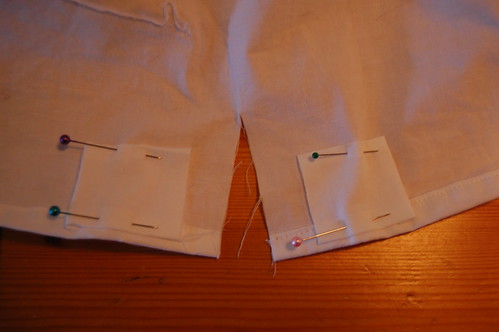
Pin these to the bottom edge, a little ways away from the slit to prevent bulk. Topstitch them in.
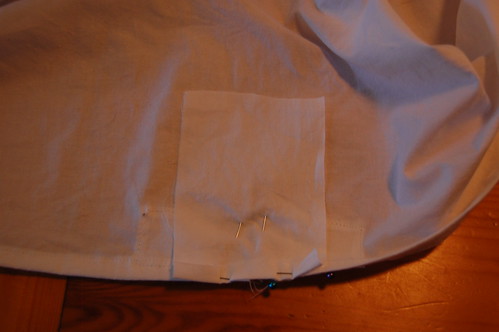
Next, cut a rectangle large enough to reach the small facings and go past the top of the slit. Pin it to the right side, with the bottom edge turned up as shown.
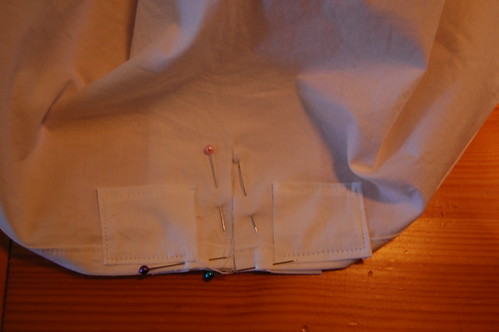
Here's what it looks like on the wrong side.
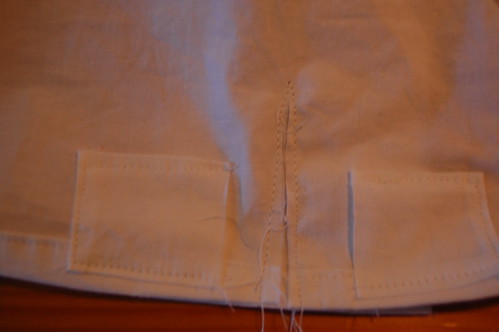
Sew this with a very narrow seam allowance that almost disappears next to the tip. Don't worry about strength, you'll be topstitching it later.
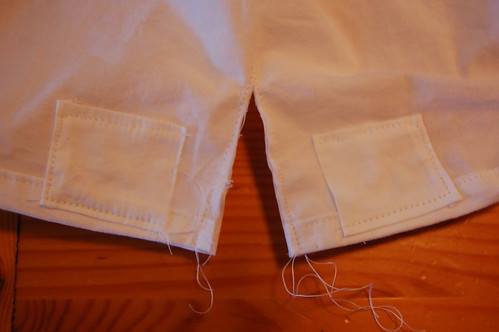
Cut the facing open, following the original slit. Cut as high as you can without cutting the sewing. This makes it turn out smoothly.
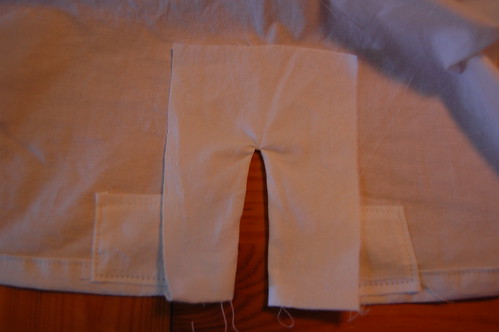
Pull the facing in to the wrong side and press. I made mine a little thicker than the original. I actually could've gotten away without the small side facings!
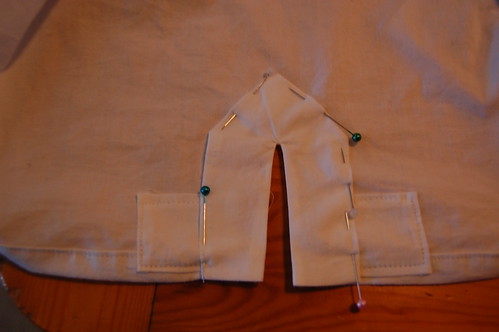
Fold the edges of the facing under, so the top is pointed like a little house. You can trim if you want, but I chose not to. I'll probably be sorry when I do the buttonhole :)
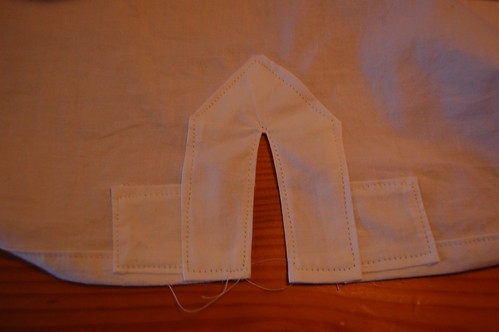
Topstitch this into place, along the outside edge and the slit.
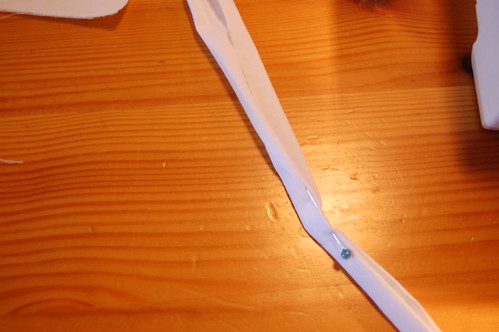
And now for the straps! The original straps are 12 inches long and half an inch wide. Cut your straps three times the desired finished width, 1 1/2 inches in this case. Then fold the edges toward the middle, and fold again, like double fold bias tape.
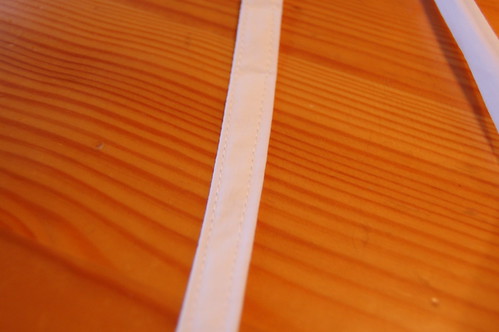
Topstitch along both sides of the strap

Pin the straps in. The back straps are a little closer to the center back than the front. This helps with slipping.

And here's where I'm going to cheat a little! I haven't done the buttons and buttonholes yet, but I wanted to do the tutorial. Here's the original, showing button and buttonhole placement. On mine, I'm going to do the buttonholes on the vertical facing, as mentioned, because I made it a little too wide.
You can also see how the lace is attached in this picture. It's hand whipped to the edge. It follows the entire bottom edge. I don't think the lace I have will stand up to this sort of thing correctly, so I need to order some!
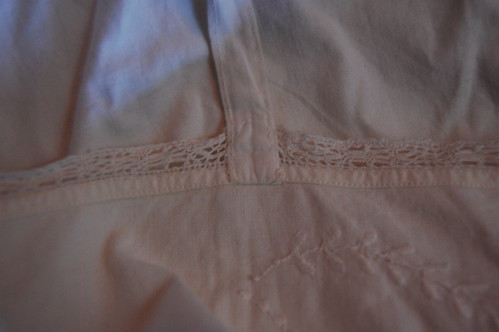
The straps are sewn on by hand with whipstitches. They're also sewn to the lace. You can also see how the lace is sewn in this picture.
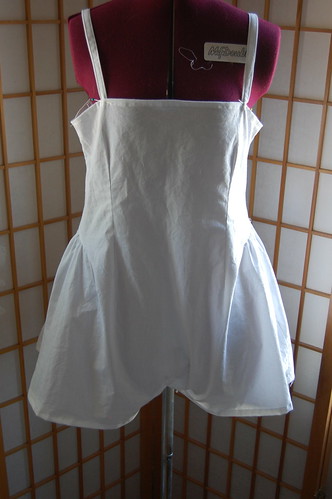
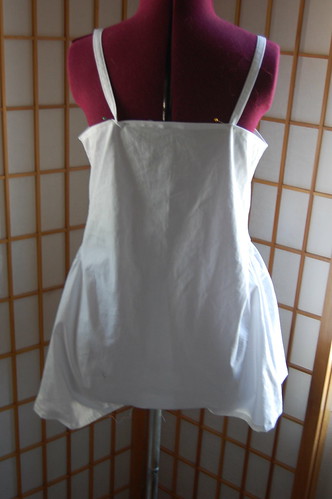
And the current state of mine! It fits me much differently than it fits the dressform. It fits quite closely under my arms, which is a benefit of it not truly being a step in when your hips and bust measurements don't match :)

No comments:
Post a Comment